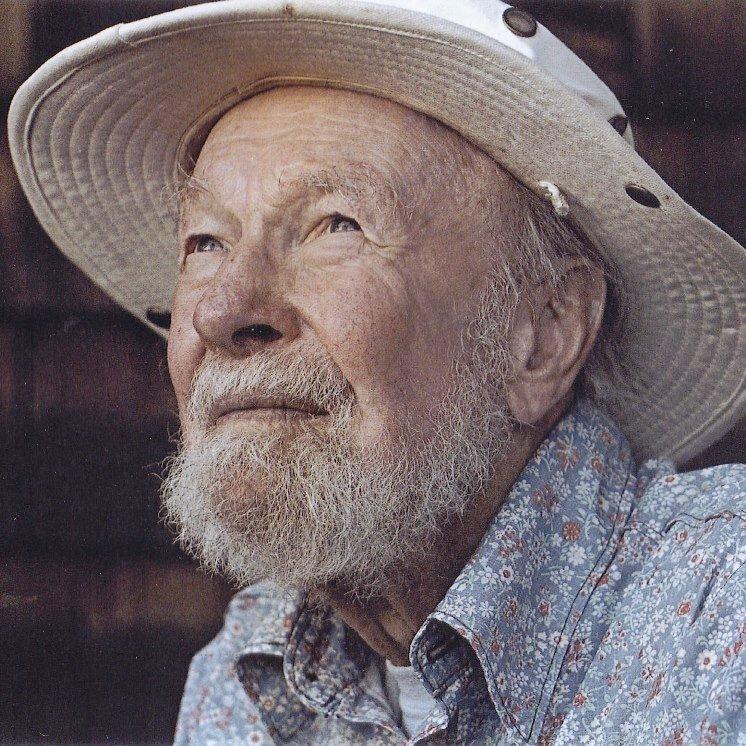Wondering how much is the net worth of Pete Seeger? Check out here, his net worth, career and more.
Pete Seegar was a very popular name in the American folk music scene. A folk musician, television host, songwriter, and social activist, Pete Seeger was very active in the music scene in America from 1939 till his death in 1914.
Pete Seeger was born on May 3, 1919 in Manhattan, New York, and lived till he was 94 years old and died on January 27, 2014.
During the 1940s, Seeger was a fixture on countrywide radio. He was a member of the Weavers and had a line of records to his credits during the 1950s like Lead Belly’s “Goodnight, Irene”, which was on top of the chart for over 13 weeks.
Following the blacklisting of the Weavers during the era of McCarthy, Seeger saw his reemergence in the protest music genre during the 1960s supporting environmental causes, civil rights, workers’ rights, counterculture, and global disarmament.
How much is the net worth of Pete Seeger?
Pete Seeger’s current net worth is estimated at $5 million. He was a very popular name in the American folk music scene. A folk musician, television host, songwriter, and social activist.
Seeger was a prolific writer of songs. He was instrumental in popularizing the spiritual song “We Shall Overcome” during the 1960s, which became the official anthem of the Civil Rights Movement.
It was Seeger who changed the line “We will overcome” into a more appealing “We shall overcome”. In 1960, Guy Carawan introduced this song at the founding meeting of SNCC (Student Nonviolent Coordinating Committee).
Net Worth Of Pete Seeger: Quick Summary
| Name | Peter Seeger |
| Popular Name | Pete Seeger |
| Birth Date | May 3, 1919 |
| Died On | January 27, 2014 |
| Birth Place | Manhattan, New York City, New York, U.S. |
| Nationality | American |
| Career Roles | Musician, songwriter, composer, presenter, social activist, and environmentalist, |
| Popular Genres | American folk music, protest music, Americana |
| Instruments | Vocals, banjo, and guitar |
| Years active in the industry | 1939 to 2014 |
| Popular labels | Folkways, Columbia, CBS, Vanguard, Sony Kids’, and SME |
| Associated Acts | The Weavers, Kabir Suman, Tao Rodríguez-Seeger, Almanac Singers, Arlo Guthrie, Phil Ochs, Bruce Springsteen, Holly Near, Ronnie Gilbert, Bob Dylan, The Sessions Band, Woody Guthrie, and Lead Belly |
| Net Worth at the time of his death in 2014 | $5 million |
| Music Groups | The Weavers, We Shall Overcome, Almanac Singers, If I Had a Hammer, Where Have All the Flowers Gone |
| Movie Shows | Alice’s Restaurant, The Ballad of Ramblin’ Jack |
| TV Shows | All You Need Is Love: The Story of Popular Music |
Net Worth Of Pete Seeger
Pete Seeger’s net worth during his death was estimated at $5 million. Besides being a prolific singer predominantly in the folk music genre, he could play several instruments including guitar, banjo, the recorder, mandolin, ukulele, piano, and tin whistle.
Pete was a renowned member of The Weavers and produced many hits during the 1950s. He was also connected with Woody Guthrie, The Almanac Singers, Tao Rodriguez-Seeger, Arlo Guthrie, and Lead Belly.

Some of Seeger’s best remembered songs are “Turn! Turn! Turn! and “Where Have All the Flowers Gone? During his career, Seeger had released over 50 records and compilations.
Best Spoken Word Album for Pete Seeger: The Storm King; Stories, Narratives, Poems fetched him a Grammy Award in 2013. He was connected with labels like Folkways, CBS, Columbia, Sony Kids’, Vanguard, and SME. Seeger had earned a huge wealth before his death in his 94th year.
Career Highlights Of Pete Seeger
Though his parents were classical musicians, they never compelled Seeger to play any instrument. Seeger was a withdrawn and bookish boy, but found an innate interest in the instrument ukulele.
Learning to play it on his own, he too entertained his classmates, which paved the basis for his subsequent career meeting larger audiences. He too learnt to play on the five string banjo.
When Seeger was 21 years old in 1941, he performed as part of the group Almanac Singers. Some of the popular works of the group were Songs For John Doe’, Talking Union, Woody Guthrie, Lee Hays, Bess Lomax Hawes, and Butch Hawes. Many of these albums were dipped in the anti-war sentiments of those times.
Songs For John Doe evoked strong reactions and copies of it were taken out from sales and the inventory remaining was damaged. Talking Union album of the Almanac singers was reissued by Folkways as an LP in 1955.
In the year following, the Almanacs released Dear Mr. President in support of Roosevelt’s war efforts, which was a solo song by Pete Seeger.

Seeger joined the services of the army in the pacific region as an airplane mechanic. Eventually, he was reassigned so that his music could entertain the American troops.
Later when people asked him what he did during the war in the army, he said, “I strummed my banjo.” During the late 1940s, Pete and a group of artists created ‘People’s Songs’, a nationwide organization to make, promote and distribute songs of the American people and the labor.
With Seeger as its director, the organization worked for the 1948 presidential campaign.
In 1943, Seeger recorded an album on Moe Asch’s Stinson label of 78s, known as Songs of the Lincoln Battalion, which contained songs like “There’s a Valley in Spain Called Jarama” and “Viva la Quince Brigada”.
Pete Seeger was the founder of two folk groups that became highly influential, called as the Weavers and The Almanac Singers. The latter was a topical group working as a singing newspaper that was meant to promote the industrial unionization movement, some progressive social causes like religious and racial inclusion.
In order to avoid impacting his father’s career with the government, Seeger performed under the stage name Pete Bowers.
The Almanac was reconstituted in the 1950s as the Weavers and the group sang songs like ‘Talking Union’ supporting the movement for unionization of industrial workers like automobile workers and miners.
One of the major hits of the Weavers was ‘On Top of Old Smoky’, and ‘Goodnight, Irene’, which topped the chart for about 13 weeks in 1950. Many other pop singers also covered this song. The other hits of the Weavers were “Dusty Old Dust”, “Kisses Sweeter Than Wine”, and “Wimoweh”.
During the peak of its popularity, the Weavers was blacklisted and the radio stations refused to play their records and their bookings got cancelled. When they returned on the stage in 1955, they made the hit version of Merle Travis’s “Sixteen Tons”.
Seeger stated in the documentary film titled as Pete Seeger: The Power of Sing released in 2007 that he quit the Weavers when some of the band members wanted to make a jingle for a cigarette commercial.
From the late 1950s, Seeger started playing on the 12-string guitar that he got custom made for himself with a triangular sound hole. In 1956, Pete travelled to Trinidad, a Port of Spain to learn about the steel pan, also known as ping-pong or steel drum. Pete was instrumental in including the highly unique flavor of the steelpan in American folk music.
During the time when the Weavers was blacklisted, Seeger worked as music teacher in schools and summer camps, and also traveled to colleges. He recorded around five albums in a year for Moe Asch’s label Folkway Records.
Seeger also reworded and popularized the ‘We Shall Overcome’, the civil rights anthem to wider listeners. Along with 1,000 marchers, he sang it on the 50-mile walk from Slema to Montgomery, Alabama.
In 2013, Seeger issued a two-CD audio book known as Pete Seeger: The Storm King; Stories, Narratives, Poems. On September 21, 2013, Pete performed at the Saratoga Performing Arts center in New York.
Pete’s Philanthropy
Seeger was a social activist and also fought for a number of causes like environmentalism. He and his wife founded the non-profit organization, ‘Hudson River Sloop Clearwater’ to press for the protection of Hudson River and the surrounding waterways and wetlands.

They constructed the sloop Clearwater, a floating ambassador for their environmental mission. They too started the annual music festival running even today under the name Great Hudson River Revival.
In 1982, Seeger performed at a benefit concert for demonstrations against the Polish government. This was deemed as the first public manifestation of Pete’s dislike of Soviet style communism.
He too used his fame to support several environmental initiatives like South Jersey’s Bayshore Center. He too was spreading environmental awareness through a large number of benefit concerts.










